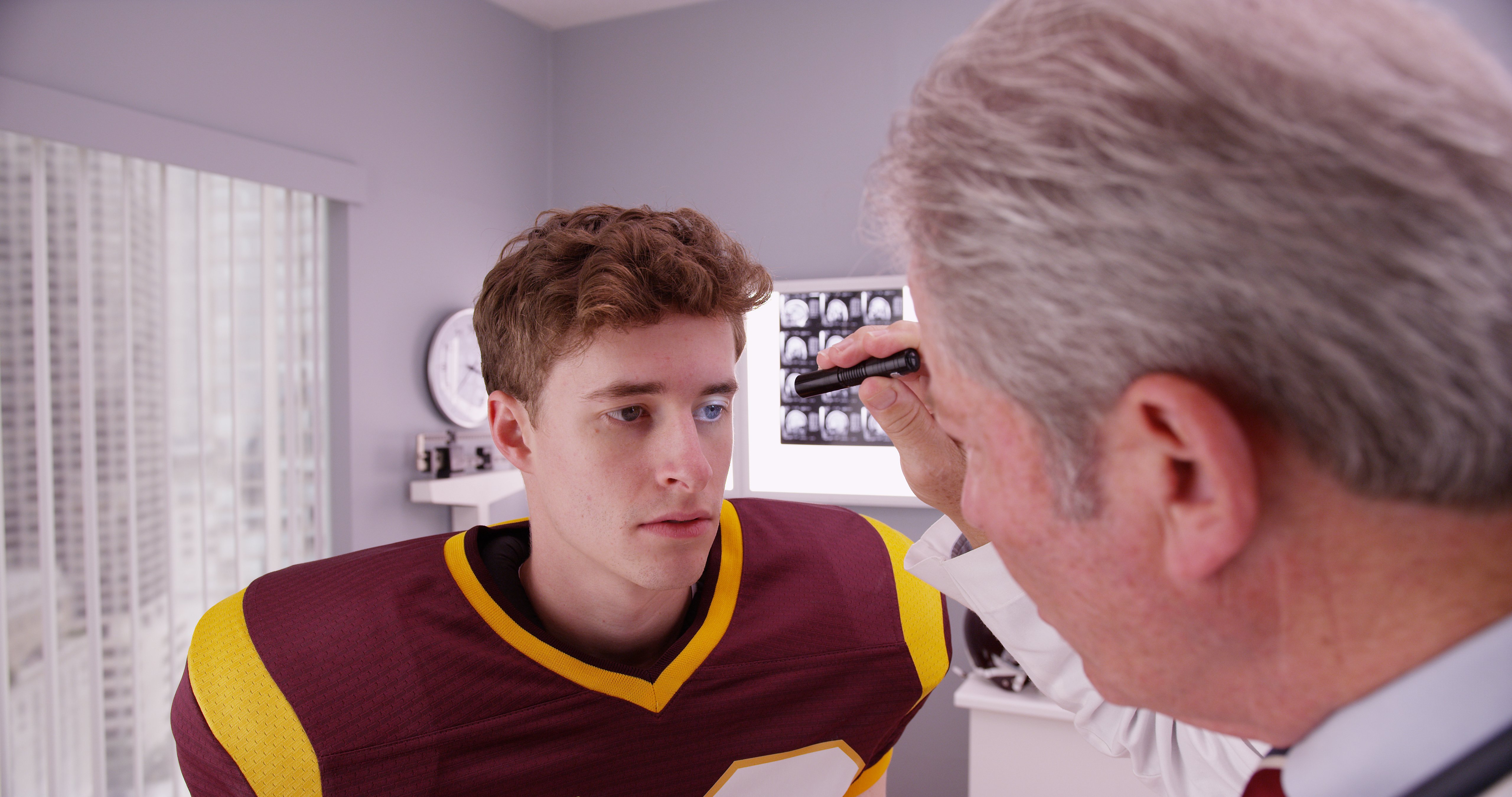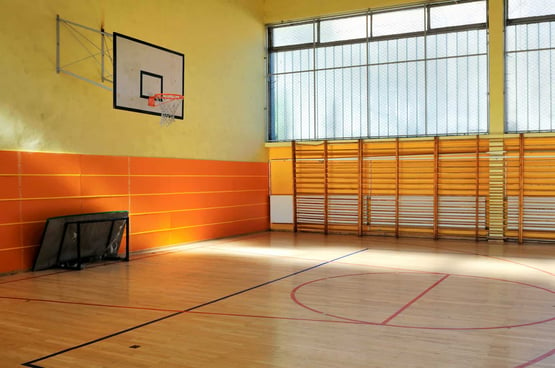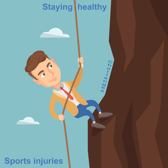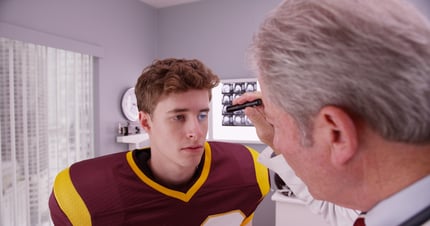Common High School Sports Injuries
September 11th, 2019 | 4 min. read


High school sports attract millions of teenagers across the country. As summer practice ramps up across the country for fall sports it's easy to see how massive high school sports are. Participation in athletics continues to be valued by parents, students, coaches, and community members.
The list of benefits to reap from children doing sports runs long, and for a good reason. Team and individual sports not only provide great exercise and help prevent chronic health problems for kids, but they also teach teamwork, discipline, equanimity, strategic thinking, self worth and help kids concentrate in the classroom. Not only are sports a very productive part of school programs; let's face it, they're fun for both kids and parents!
- When sports-related injuries happen, it can be a letdown for all involved.
- The student-athlete will suffer not only from the injury, but lost time at school, with friends, and at practice. They may even lose an entire season or career.
- Parents, coaches, and the community often frame their expectations on a team's players; an injury can quickly cast a shadow on high hopes for a team or individual.
- For those families seeking opportunities through athletic scholarships, injuries can quickly unravel their plans for the future.
- Injuries can quickly make one challenge the rewords of sports, but adversity is an important lesson; with proper training most injuries can be overcome and lessons learned without much loss in time or opportunity to the player.

The challenges above illustrate how it's important that our young athletes get immediate treatment when they have injuries.This time of year, orthopedists expect to see quite a few baseball injuries and softball injuries for players on the local high school teams. It's not that adolescent athletes are less proficient or more reckless, but that they are, unlike their adult counterparts, "works in progress." Because they are still growing, injuries to their bones and muscles require specialized care and observation to ensure they heal correctly. Timing is often compounded later in high school as they seek scholarships and future league options.
At this time in a teenager's life, bones are growing faster than the muscles and tendons that hold them together. Minor injuries, if left untreated, can result in joining the "injured list" for the season.
By ensuring proper healing with this in mind, the goal is to treat both minor and acute injuries to keep them healthy to reduce their risk for corrective surgery or the development of arthritis in adulthood.
The most common types of high school sports injuries
Certain kinds of injuries run common to all high school athletic activities. They can be classified under the following five main types of sport-related injuries.
Acute Injuries
You can think of these as the result of sudden trauma—mostly collisions on the field or between players or playing equipment. These include unexpected twists or falls, as well, which can lead to:
-
Contusions (bruises)
-
Sprains (partial or complete tears of ligaments)
-
Strains (partial or complete tears of muscle)
-
Fractures (partial or complete breaks in bones)
Overuse Injuries
Different sports have different kinds of overuse injuries related to the muscle and bone groups, most often tested during training and competition.
Repetitive movement over the season can lead to body fatigue from overuse. Muscles need healing time between intense workouts to recover, but too much performance without adequate rest can lead to injuries. These affect not only muscles and ligaments, but tendons, growth plates, and bones.
Stress bone fractures are also common. An adolescent's bones are constantly building new bone. High activity leads to a quicker breakdown of old bone, but the new bone development may not be strong enough to handle the accelerated stress of athletic performance. Typically, the shin bones and the bones of the feet are most likely to fracture due to stress.
Catastrophic Sports Injuries
The National Center for Catastrophic Sport Injury Research classifies catastrophic injuries as either leading to "fatality, causing permanent severe functional disability, or causing severe head or neck trauma with no permanent disability."
Contact sports, in particular, put kids playing sports at risk for severe injuries, even when safety equipment is used. However, participation in all sports (diving, for instance) is inherently risky and can lead to catastrophic injuries to the head and neck and even brain or spinal cord damage.
Concussions
Concussions are mild traumatic brain injuries caused by a direct blow to the head or body that causes jarring movement to

the brain inside the skull.
The American Academy of Pediatrics began making recommendations about concussion evaluation and clearance in 2010 toprevent kids from returning too soon to competition in order to keep them safe. The American Academy of Neurology followed by establishing higher standards for training physicians to assess better and manage sports-related concussions.
Concussions can happen in all sports, though they are typically more likely to occur in certain sports, such as soccer, football, and ice hockey.
Growth Plate Injuries
The growth plates are found near the ends of long bones such as the arm and leg bones. These areas of cartilage are still developing along with the bones and won't completely harden until the child is fully grown. This means they are vulnerable to fracture for active teens participating in sports.
The problem with breaks in the growth plates is that they are essential for shaping and determining the final length of adult bones. If they are broken and don't heal properly, they can limit future bone growth and even misshape the new bone yet to develop. Injuries in these areas are common in high impact sports such as gymnastics, football, or basketball.
It's easy to think that your teenaged kids have grown into their adult bodies, but they are still finishing their physical development. Don't delay having your child checked out for a sport-related injury, even if they resist or seem fine. Symptoms may not present immediately but could worsen overnight. Immediate attention is key to keeping them healthy and strong, not only in high school but for the remainder of their lives.
Article written by: Rob Williams, MD
Coastal Orthopedics is proud to serve as Flour Bluff High School's official orthopedist. As sports injury specialists, we understand that injuries happen, but they do not have to stand in your way. Please allow us to help you to help your family with their orthopedics complaints and concerns. Call us today in Corpus Christi at (361) 994-1166
Dr. Williams has been practicing orthopedic surgery in Corpus Christi since 1998. After graduating from Texas Tech hereceived his medical degree from the University of Texas at San Antonio. At the prestigious Campbell Clinic located at the University of Tennessee, Dr. Williams completed not only an Orthopedic Surgery Residency, but an additional year of Fellowship Training in Spine Surgery. Dr. Williams is dedicated to creating an excellent patient experience in the office or in the surgery suite.
Topics:

